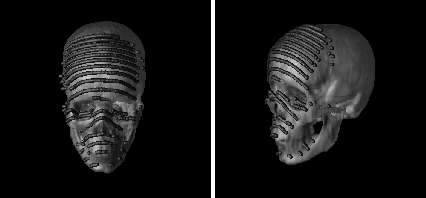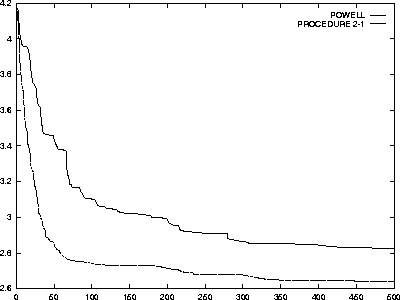



Next: Molecule energy minimization
Up: Results and related
Previous: De Jong's test
There is recent study on frameless guidance systems to aid neurosurgeons in
planning operations [Grimson et al., 1994]. A method has been developed for
registering clinical data, such as segmented MRI or CT reconstructions, with
the actual head of the patient, for which position and orientation information
is provided by a laser scanning device. The data obtained from the scanning
device is much coarser than that from MRI or CT. Figure  illustrates the two data sets overlaid. The detailed picture of the skull is
obtained from its MRI scan, and the horizontal lines are the result of the
laser scan. Furthermore, the coordinate frame of the laser device is different
from the MRI device. To be able to register the two data sets, one needs to
find the appropriate 3-dimensional transformation that will map them. At this
point the problem can be seen as an optimization problem with six parameters.
The parameters are the three distances and three angles of the transformation.
The objective function measures the distance of the points in the laser scan
data to their closest neighbors in the MRI data. The value returned is the
mean squared distance.
illustrates the two data sets overlaid. The detailed picture of the skull is
obtained from its MRI scan, and the horizontal lines are the result of the
laser scan. Furthermore, the coordinate frame of the laser device is different
from the MRI device. To be able to register the two data sets, one needs to
find the appropriate 3-dimensional transformation that will map them. At this
point the problem can be seen as an optimization problem with six parameters.
The parameters are the three distances and three angles of the transformation.
The objective function measures the distance of the points in the laser scan
data to their closest neighbors in the MRI data. The value returned is the
mean squared distance.

Figure:
The coordinate registration problem in image guided surgery. The figures show
two examples of the laser scan data (horizontal lines) overlaid on the MRI data
(the skulls). The problem is to find the transformation that will align these
two data sets.
In the project, Powell's method has been used for optimization.
Figure  shows a comparison between Powell's method and Procedure
2-1. Powell's method fails to find a good solution if the initial
configuration is too far from the global optimum. Procedure 2-1 not only finds
better points, but also is able to do so from configurations that are further
away.
shows a comparison between Powell's method and Procedure
2-1. Powell's method fails to find a good solution if the initial
configuration is too far from the global optimum. Procedure 2-1 not only finds
better points, but also is able to do so from configurations that are further
away.

Figure:
The comparison of Procedure 2-1 with Powell's method on the coordinate
registration problem. The y axis shows the root mean squared distance in
millimeters, the x axis is the number of function evaluations. The results are
averaged over ten runs.




Next: Molecule energy minimization
Up: Results and related
Previous: De Jong's test
Deniz Yuret
Tue Apr 1 21:38:29 EST 1997
 illustrates the two data sets overlaid. The detailed picture of the skull is
obtained from its MRI scan, and the horizontal lines are the result of the
laser scan. Furthermore, the coordinate frame of the laser device is different
from the MRI device. To be able to register the two data sets, one needs to
find the appropriate 3-dimensional transformation that will map them. At this
point the problem can be seen as an optimization problem with six parameters.
The parameters are the three distances and three angles of the transformation.
The objective function measures the distance of the points in the laser scan
data to their closest neighbors in the MRI data. The value returned is the
mean squared distance.
illustrates the two data sets overlaid. The detailed picture of the skull is
obtained from its MRI scan, and the horizontal lines are the result of the
laser scan. Furthermore, the coordinate frame of the laser device is different
from the MRI device. To be able to register the two data sets, one needs to
find the appropriate 3-dimensional transformation that will map them. At this
point the problem can be seen as an optimization problem with six parameters.
The parameters are the three distances and three angles of the transformation.
The objective function measures the distance of the points in the laser scan
data to their closest neighbors in the MRI data. The value returned is the
mean squared distance.





